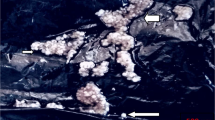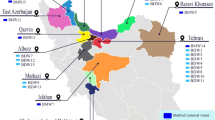Abstract
This study assessed the impacts of dietary arsenic trioxide (As2O3) on 26 mineral element contents in the liver and kidney of chicken. A total of 100 male Hy-line cocks were randomly divided into 2 groups (50 chickens in each group), including an arsenic-treated group (basic diet supplemented with As2O3 at 30 mg/kg) and a control group (basal diet). The feeding experiment lasted for 90 days and the experimental animals were given free access to feed and water. We determined 26 mineral elements in the liver and kidney by inductively coupled plasma mass spectrometry (ICP-MS). The results showed that nine element levels (Al, Mn, Co, Cu, Zn, Se, Cd, Ba, and Pb) were significantly decreased (P < 0.05) in the liver of chickens exposed to As2O3 compared to the control chickens where three element levels (Ni, As, and Hg) increased significantly (P < 0.05). The results in the kidney showed that nine element levels (Al, K, Ca, Cr, Mn, Ni, Sb, Ba, and Pb) were significantly decreased (P < 0.05) in the chickens exposed to As2O3 compared to the control chickens where four element levels (Mo, As, Cd, and Hg) increased significantly (P < 0.05). These results suggest that supplementation of high levels of arsenic affected trace mineral levels in the liver and kidney of chicken, and the effects vary from organ to organ. The aim of this study is to provide references for further study of heavy metal poisoning by detecting the contents of minerals induced by arsenic in chicken.


Similar content being viewed by others
References
Adeyemi JA, Da CMA, Barbosa FJ (2015) Teratogenicity, genotoxicity and oxidative stress in zebrafish embryos (Danio rerio) co-exposed to arsenic and atrazine. Comp Biochem Physiol C Toxicol Pharmacol 172-173:7–12
Ahmed MK, Shaheen N, Islam MS, Habibullah-al-Mamun M, Islam S, Mohiduzzaman M, Bhattacharjee L (2015) Dietary intake of trace elements from highly consumed cultured fish (Labeo rohita, Pangasius pangasius and Oreochromis mossambicus) and human health risk implications in Bangladesh. Chemosphere 128:284–292
Altikat S, Uysal K, Kuru HI, Kavasoglu M, Ozturk GN, Kucuk A (2015) The effect of arsenic on some antioxidant enzyme activities and lipid peroxidation in various tissues of mirror carp (Cyprinus carpio carpio). Environ Sci Pollut Res Int 22(5):3212–3218
Al-Waeli A, Pappas AC, Zoidis E, Georgiou CA, Fegeros K, Zervas G (2012) The role of selenium in cadmium toxicity: interactions with essential and toxic elements. Br Poult Sci 53(6):817–827
Aoun M, Arnaudguilhem C, El SO, Khozam RB, Lobinski R (2015) Impact of a phosphate fertilizer plant on the contamination of marine biota by heavy elements. Environ Sci Pollut Res Int 22(19):14940–14949
Argos M, Kalra T, Rathouz PJ, Chen Y, Pierce B, Parvez F, Islam T, Ahmed A, Rakibuz-Zaman M, Hasan R, et al. (2010) Arsenic exposure from drinking water, and all-cause and chronic-disease mortalities in Bangladesh (HEALS): a prospective cohort study. Lancet 376(9737):252–258
Basu A, Mahata J, Gupta S, Giri AK (2001) Genetic toxicology of a paradoxical human carcinogen, arsenic: a review. Mutat Res 488(2):171–194
Celik U, Oehlenschlager J (2007) High contents of cadmium, lead, zinc and copper in popular fishery products sold in Turkish supermarkets. Food Control 18:258–261
Chevallier E, Chekri R, Zinck J, Guérin T, Noël L (2015) Simultaneous determination of 31 elements in foodstuffs by ICP-MS after closed-vessel microwave digestion: method validation based on the accuracy profile. J Food Comp Anal 41:35–41
Coelho P, Costa S, Silva S, Walter A, Ranville J, Sousa AC, Costa C, Coelho M, Garcia-Leston J, Pastorinho MR, et al. (2012) Metal(loid) levels in biological matrices from human populations exposed to mining contamination—Panasqueira mine (Portugal). J Toxicol Environ Health A 75(13–15):893–908
Ebdon L, Pitts L, Cornelis R, Crews H, Donard OFX, Quevauviller P (2001) Trace element speciation for environment, food and health. Royal Society. Chem. Cambridge 331–353
Gerber N, Brogioli R, Hattendorf B, Scheeder MR, Wenk C, Gunther D (2009) Variability of selected trace elements of different meat cuts determined by ICP-MS and DRC-ICPMS. Animal 3(1):166–172
Giannenas I, Nisianakis P, Gavriil A, Kontopidis G, Kyriazakis I (2009) Trace mineral content of conventional, organic and courtyard eggs analysed by inductively coupled plasma mass spectrometry (ICP-MS). Food Chem 114:706–711
Guidotti L, Queipo AS, Rodriguez-Gonzalez P, Garcia AJ, Beone GM (2015) Quantification of Cr(VI) in soil samples from a contaminated area in northern Italy by isotope dilution mass spectrometry. Environ Sci Pollut Res Int 22(22):17569–17576
Guo Y, Zhao P, Guo G, Hu Z, Tian L, Zhang K, Zhang W, Xing M (2015) The role of oxidative stress in gastrointestinal tract tissues induced by arsenic toxicity in cocks. Biol Trace Elem Res 168(2):490–499
Harding LE, Graham M, Paton D (2005) Accumulation of selenium and lack of severe effects on productivity of American dippers (Cinclus mexicanus) and spotted sandpipers (Actitis macularia). Arch Environ Contam Toxicol 48(3):414–423
Hei TK, Liu SX, Waldren C (1998) Mutagenicity of arsenic in mammalian cells: role of reactive oxygen species. Proc Natl Acad Sci U S A 95(14):8103–8107
Jovicic K, Nikolic DM, Visnjic-Jeftic Z, Dikanovic V, Skoric S, Stefanovic SM, Lenhardt M, Hegedis A, Krpo-Cetkovic J, Jaric I (2015) Mapping differential elemental accumulation in fish tissues: assessment of metal and trace element concentrations in Wels catfish (Silurus glanis) from the Danube River by ICP-MS. Environ Sci Pollut Res Int 22(5):3820–3827
Li G, Sun GX, Williams PN, Nunes L, Zhu YG (2011) Inorganic arsenic in Chinese food and its cancer risk. Environ Int 37(7):1219–1225
Li JL, Jiang CY, Li S, Xu SW (2013) Cadmium induced hepatotoxicity in chickens (Gallus Domesticus) and ameliorative effect by selenium. Ecotoxicol Environ Saf 96:103–109
Lin Y, Munroe P, Joseph S, Ziolkowski A, van Zwieten L, Kimber S, Rust J (2013) Chemical and structural analysis of enhanced biochars: thermally treated mixtures of biochar, chicken litter, clay and minerals. Chemosphere 91(1):35–40
Liu X, Li Z, Han C, Zhang Z, Xu S (2012) Effects of dietary manganese on Cu, Fe, Zn, Ca, Se, IL-1beta, and IL-2 changes of immune organs in cocks. Biol Trace Elem Res 148(3):336–344
Liu X, Zhang W, Hu Y, Hu E, Xie X, Wang L, Cheng H (2015) Arsenic pollution of agricultural soils by concentrated animal feeding operations (CAFOs). Chemosphere 119:273–281
Liu XF, Li ZP, Tie F, Liu N, Zhang ZW, Xu SW (2013) Effects of manganese-toxicity on immune-related organs of cocks. Chemosphere 90(7):2085–2100
Liu Y, Guyton KZ, Gorospe M, Xu Q, Lee JC, Holbrook NJ (1996) Differential activation of ERK, JNK/SAPK and P38/CSBP/RK map kinase family members during the cellular response to arsenite. Free Radic Biol Med 21(6):771–781
Lynch HN, Greenberg GI, Pollock MC, Lewis AS (2014) A comprehensive evaluation of inorganic arsenic in food and considerations for dietary intake analyses. Sci Total Environ 496:299–313
Millour S, Noel L, Chekri R, Vastel C, Guérin T (2011) Simultaneous analysis of 21 elements in foodstuffs by ICP-MS after closed-vessel microwave digestion: method validation. J Food Compos Anal 24:111–112
Mondal MK, Das TK, Biswas P, Samanta CC, Bairagi B (2007) Influence of dietary inorganic and organic copper salt and level of soybean oil on plasma lipids, metabolites and mineral balance of broiler chickens. Animal Feed Sci Technol 139:212–233
Naraharisetti SB, Aggarwal M, Ranganathan V, Sarkar SN, Kataria M, Malik JK (2009) Effects of simultaneous repeated exposure at high levels of arsenic and malathion on hepatic drug-biotransforming enzymes in broiler chickens. Environ Toxicol Pharmacol 28(2):213–218
Nachman KE, Francesconi GKA, Navas-Acien A, Love DC (2012) Raber arsenic species in poultry feather meal. Sci Total Environ 417–418:183–188
Nisianakis P, Giannenas I, Gavriil A, Kontopidis G, Kyriazakis I (2009) Variation in trace element contents among chicken, turkey, duck, goose, and pigeon eggs analyzed by inductively coupled plasma mass spectrometry (ICP-MS). Biol Trace Elem Res 128(1):62–71
Papagiannis I, Kagalou I, Leonardos J, Petridis D, Kalfakakou V (2004) Copper and zinc in four freshwater fish species from Lake Pamvotis (Greece). Environ Int 30(3):357–362
Pappas AC, Zoidis E, Georgiou CA, Demiris N, Surai PF, Fegeros K (2011) Influence of organic selenium supplementation on the accumulation of toxic and essential trace elements involved in the antioxidant system of chicken. Food Addit Contam Part A Chem Anal Control Expo Risk Assess 28(4):446–454
Pouretedal HR, Rafat M (2007) Simultaneous determination of nickel (II) and copper (II) by second-derivative spectrophotometric method in micellar media. J Chin Chem Soc 54:157–164
Rodriguez VM, Jimenez-Capdeville ME, Giordano M (2003) The effects of arsenic exposure on the nervous system. Toxicol Lett 145(1):1–18
Sanchez-Virosta P, Espin S, Garcia-Fernandez AJ, Eeva T (2015) A review on exposure and effects of arsenic in passerine birds. Sci Total Environ 512-513:506–525
Shah AQ, Kazi TG, Arain MB, Jamali MK, Afridi HI, Jalbani N, et al. (2009) Comparison of electrothermal and hydride generation atomic absorption spectrometry for the determination of total arsenic in broiler chicken. Food Chem 113:1351–1355
Sohel N, Persson LA, Rahman M, Streatfield PK, Yunus M, Ekstrom EC, Vahter M (2009) Arsenic in drinking water and adult mortality: a population-based cohort study in rural Bangladesh. Epidemiology 20(6):824–830
Sun B, Wang R, Li J, Jiang Z, Xu S (2011) Dietary selenium affects selenoprotein W gene expression in the liver of chicken. Biol Trace Elem Res 143(3):1516–1523
Tuzen M (2003) Determination of heavy metals in fish samples of the middle Black Sea (Turkey) by graphite furnace atomic absorption spectrometry. Food Chem 80:119–123
Uluozlu OD, Tuzen M, Mendil D, Soylak M (2009) Assessment of trace element contents of chicken products from Turkey. J Hazard Mater 163(2–3):982–987
Waghe P, Sarath TS, Gupta P, Kutty HS, Kandasamy K, Mishra SK, Sarkar SN (2014) Subchronic arsenic exposure through drinking water alters vascular redox homeostasis and affects physical health in rats. Biol Trace Elem Res 162(1–3):234–241
WHO (2010) Exposure to arsenic: a major public health concern. Geneva: WHO Press. http://www.who.int/ipcs/assessment/public_health/arsenic/en/. Accessed 23 Oct 2013
Xia B, Cao H, Luo J, Liu P, Guo X, Hu G, Zhang C (2015) The co-induced effects of molybdenum and cadmium on antioxidants and heat shock proteins in duck kidneys. Biol Trace Elem Res 168(1):261–268
Xing M, Zhao P, Guo G, Guo Y, Zhang K, Tian L, He Y, Chai H, Zhang W (2015) Inflammatory factor alterations in the gastrointestinal tract of cocks overexposed to arsenic trioxide. Biol Trace Elem Res 167(2):288–299
Xu T, Gao X, Liu G (2016) The antagonistic effect of selenium on lead toxicity is related to the ion profile in chicken liver. Biol Trace Elem Res 169(2):365–373
Yang S, Zhang Z, He J, Li J, Zhang J, Xing H, Xu S (2012) Ovarian toxicity induced by dietary cadmium in hen. Biol Trace Elem Res 148(1):53–60
Yuan J, Xu Z, Huang C, Zhou S, Guo Y (2011) Effect of dietary Mintrex-Zn/Mn on performance, gene expression of Zn transfer proteins, activities of Zn/Mn related enzymes and fecal mineral excretion in broiler chickens. Animal Feed Sci Technol 168:72–77
Acknowledgments
This study was supported by the Natural Science Foundation of Heilongjiang Province (Grant No. C2015061).
Author information
Authors and Affiliations
Corresponding authors
Ethics declarations
Conflict of interest
The authors declare that they have no conflicts of interest.
Additional information
Responsible editor: Philippe Garrigues
Ying He and Bonan Sun contributed equally to this work
Rights and permissions
About this article
Cite this article
He, Y., Sun, B., Li, S. et al. Simultaneous analysis 26 mineral element contents from highly consumed cultured chicken overexposed to arsenic trioxide by inductively coupled plasma mass spectrometry. Environ Sci Pollut Res 23, 21741–21750 (2016). https://doi.org/10.1007/s11356-016-7318-5
Received:
Accepted:
Published:
Issue Date:
DOI: https://doi.org/10.1007/s11356-016-7318-5




